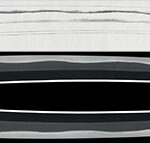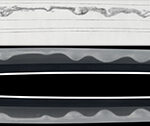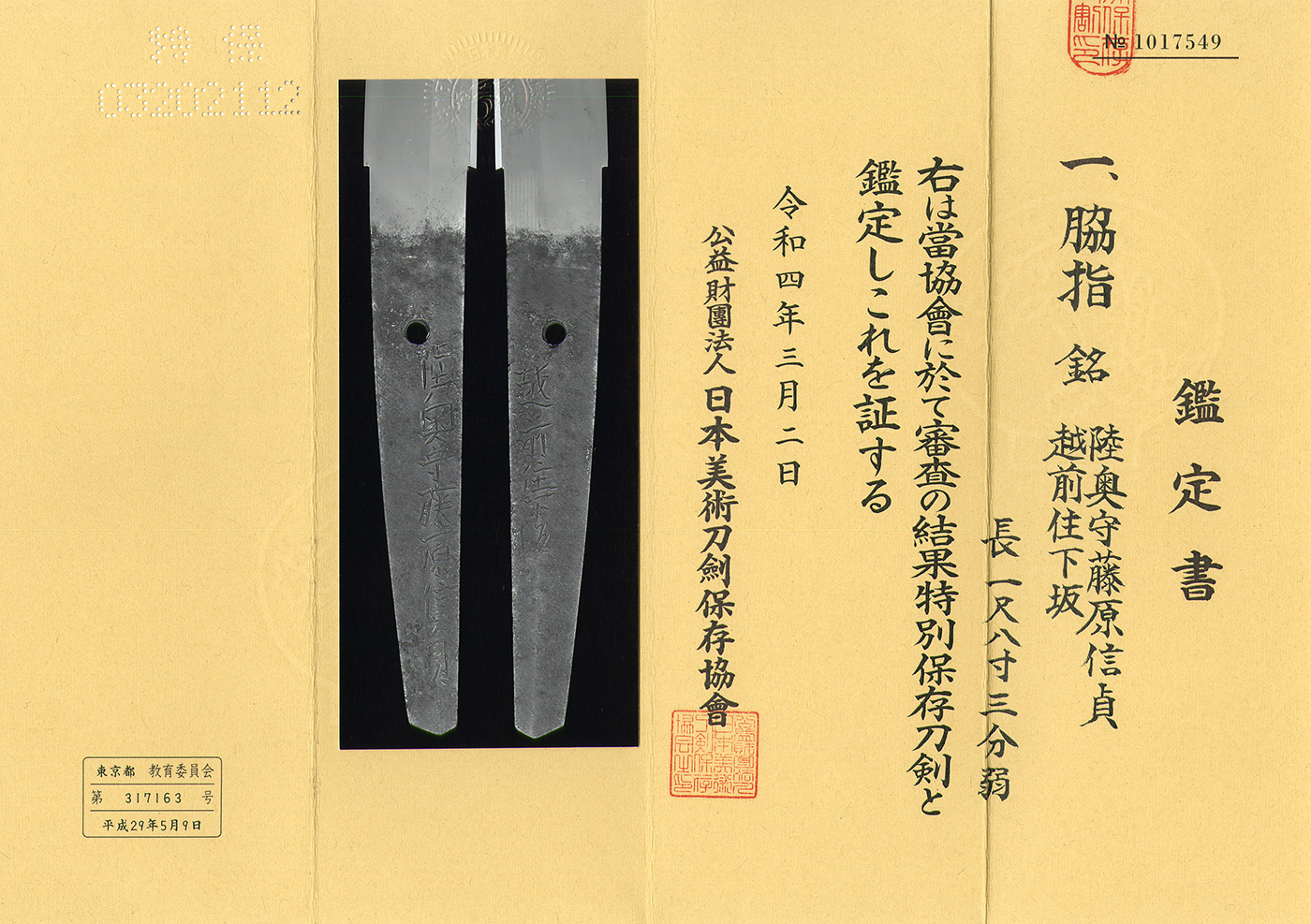Ordering number:23354
Wakizashi In Shirasaya (NBTHK Hozon Token)
Inscription: Mutsu-no-Kami Fujiwara Nobusada
陸奥守藤原信貞
Echizen Ju Shimosaka
越前住下坂
At our company, we categorize swords based on the craftsmanship of the swordsmith into Saijo Saku, Jojo Saku, Jo Saku, and Futsu Saku. This work's craftsmanship is ranked as Jojo Saku.
Polished.
Habaki: Gold foiled single layer
Blade Length: 55.4 cm
Curvature: 1.5 cm
Peg Hole: 1 hole
Width at Base: 3.03 cm
Width at Tip: 2.08 cm
Thickness: 0.63 cm
Weight of Sword: 535 grams
Era: Edo Period, Enpō era (1673-1681)
Shape: The blade has a wide body, noticeable thickness, and a slightly deep curvature. It features a single peg hole.
Grain Pattern: The surface has a fine ko-itame grain pattern that is well-kneaded, and the wood grain is visible. The edge has a mokume grain pattern on the surface and a masame grain pattern can also be observed, reflecting the antiquity of the era.
Tempering Pattern: The hamon is a deep notare mix, with well-executed large and small gunome forms, bright and clear. The temper line interacts with the bright and dark areas, and there are streaks of sunagashi mixed with kin-suji. The bōshi (tempered line tip) is round and returns gently.
Characteristics: Mutsu-no-Kami Fujiwara Nobusada was a swordsmith during the Edo period in the Enpō era. He is also known as Shimozaka 2nd generation. Additionally, there is a 2nd generation Shimozaka who used the title "Sabeinojo" (Head of Sabe family) with the name "Mutsu-no-Kami Fujiwara Nobusada" (in 1706). While some aspects are difficult to determine, based on my perspective, it is believed that either the 11th generation Mutsu-no-Kami or the 2nd generation Shimozaka around the Genroku 3rd year (1690) are the closest possibilities.
Historical Background: From around the Genroku period of the Edo era to the late Edo period, including the Kansei and Kyōwa eras, swordsmiths faced challenges in creating swords due to the difficulty of obtaining high-quality materials. This era was characterized by the need for the support of influential domains and daimyos in order for swords to sell well, as the quality of the tempering pattern was pivotal.
NBTHK Hozon Token paper
Aoi Art estimation paper: whole Oshigata by Ayaka Tsuruta
Price:400,000 JPY-.
商談中 HOLD
Related Items:
 Wakizashi:Hoki Kami Ason Masayuki/Kansei 6 Nen 8 Gatsu Hi(NBTHK Tokubetsu Hozon Token)
Wakizashi:Hoki Kami Ason Masayuki/Kansei 6 Nen 8 Gatsu Hi(NBTHK Tokubetsu Hozon Token)
 Wakizashi: Omi Daijo Fujiwara Tadayoshi (4th Generation)(NBTHK Tokubetsu Hozon Token)
Wakizashi: Omi Daijo Fujiwara Tadayoshi (4th Generation)(NBTHK Tokubetsu Hozon Token)
 Wakizashi:Hoki no Kami Taira Ason Masayuki/Kansei 4 Nen Ne 8 Gatsu(NBTHK Tokubetsu Hozon Token)
Wakizashi:Hoki no Kami Taira Ason Masayuki/Kansei 4 Nen Ne 8 Gatsu(NBTHK Tokubetsu Hozon Token)
 Wakizashi:Echigo no Kami Kanesada(NBTHK Tokubetsu Hozon Token) (Consignment Sale)
Wakizashi:Echigo no Kami Kanesada(NBTHK Tokubetsu Hozon Token) (Consignment Sale)
 Wakizashi: Yamashiro Daijyo Minamoto Kuishige(NBTHK Tokubetsu Hozon Token)
Wakizashi: Yamashiro Daijyo Minamoto Kuishige(NBTHK Tokubetsu Hozon Token)
 Wakizashi: (Kiku-Mon) Raijo Iga no Kami Fujiwara Kinmichi (5th generation)
Wakizashi: (Kiku-Mon) Raijo Iga no Kami Fujiwara Kinmichi (5th generation)




